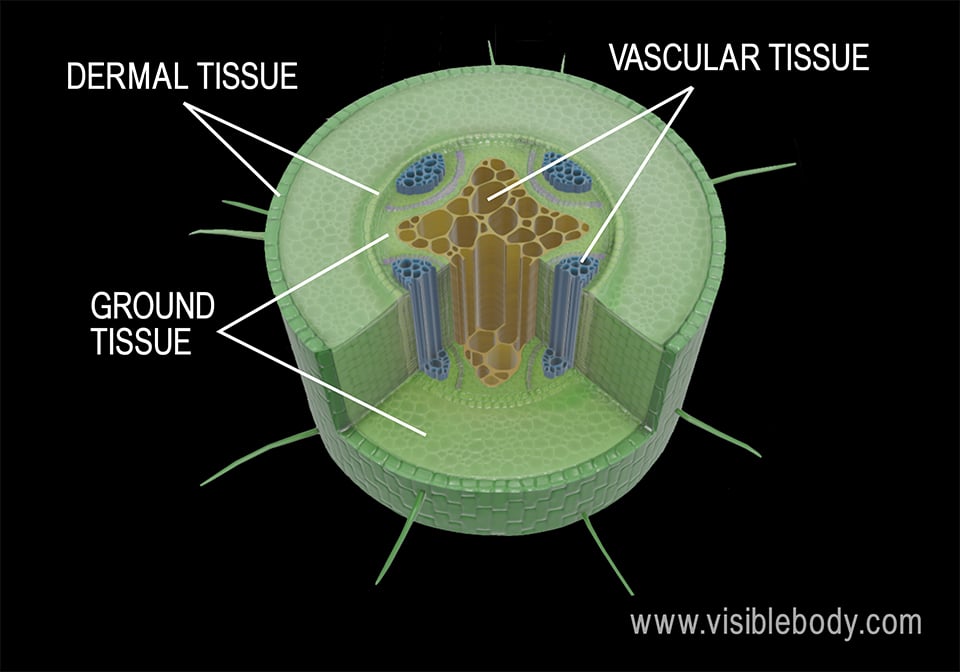Flowering plants, also known as angiosperms, are vascular plants—meaning they have a transportation system that allows water, minerals, and food to move throughout the plant. They are composed of three types of tissue: dermal tissue, vascular tissue, and ground tissue.

Dermal tissue is the “skin” of the plant, protecting it from damage. Most leaves, as well as some roots and stems, have a waxy layer called the cuticle that covers the dermal tissue. The cuticle helps the plant retain water, protects the plant against UV rays, and prevents pathogens from entering the plant.
Vascular tissue—like veins and arteries in the human body—moves water, nutrients, and food through all the parts of the plant. There are two main types of vascular tissue in plants: the xylem and phloem. The xylem carries water and dissolved minerals upward—from the root, through the stem, to the leaves. The phloem carries dissolved sugars and organic compounds, made by the cells in the leaves, downward to supply the plant’s stem and root. Together, the xylem and phloem form vascular bundles throughout the plant’s interior.
Ground tissue makes up most of the plant’s interior. It provides structural support and contains cells that carry out key functions such as photosynthesis, gas exchange, respiration, and the storage of water and starch. There are three types of ground tissue cells: parenchyma, collenchyma, and sclerenchyma.
Monocots and dicots are the two major types of flowering plants. Did you notice the prefixes in monocot and dicot? These refer to how many cotyledons the plant’s seed contains. Cotyledons are structures that provide energy and nutrients to the young plant. Monocots have one cotyledon, and dicots have two.
Monocots and dicots differ in several other major ways, as well. For example, monocots (ex. lilies) have flower parts that appear in groups of three, and dicots (ex. pansies) have flower parts in groups of four or five. In addition, monocots are monosulcate, meaning that their pollen grains have one furrow or groove, whereas dicots are trisulcate, meaning that their pollen grains typically have three furrows or grooves.
Further differences between monocots and dicots can be seen in the structure of their three main parts: the roots, stems, and leaves.
Roots
The roots allow plants to absorb water and nutrients from the soil. Monocot roots are fibrous, meaning they form a wide network of thin roots that originate from the stem and stay close to the soil surface. Dicot roots have a central “taproot,” meaning they form a single thick root, with lateral branches, that grows deep into the soil.
Stems
Stems make plants stand tall, supporting their leaves and flowers. Vascular structures in the stem move water and nutrients upward from the root to the leaves and transport food downward from the leaves to the root. Monocot stems have bundles of vascular tissue scattered throughout, whereas vascular bundles in dicot stems are arranged in a ring.
Leaves
Leaves are the plant’s food factories. Leaves receive water and nutrients from the root via vascular structures in the stem. They also absorb light and take in carbon dioxide. Parenchyma cells in the leaves carry out photosynthesis to produce sugar that the plant can break down for energy later. Pores called stomata allow carbon dioxide to enter the leaf and water vapor and oxygen to leave it. Monocot leaves have parallel vasculature, whereas dicot leaves have net-like vasculature.
Photosynthesis is the process by which plants use water, carbon dioxide, and sunlight to create food in the form of sugars. During photosynthesis, plants produce oxygen, which is released into the air.
A plant’s roots, stem, and leaves each contribute to this process. Roots allow plants to absorb water from the soil. The xylem—one of the types of vascular tissue—carries this water up through the stem and to the leaves.
The leaves absorb light and take in carbon dioxide. They contain the majority of the cells that carry out photosynthesis and produce sugar molecules. The phloem—another type of vascular tissue—carries these sugar molecules from the leaves to the rest of the plant. The plant’s cells break down the sugar molecules when they need energy to carry out the processes necessary for their survival.
A video on vascular plant structure from Crash Course Biology.
A video from Untamed Science contrasting monocots and dicots.
A summary of monocot and dicot plant structures from the University of California Museum of Paleontology.
An overview of the xylem and phloem from Khan Academy.
When you select "Subscribe" you will start receiving our email newsletter. Use the links at the bottom of any email to manage the type of emails you receive or to unsubscribe. See our privacy policy for additional details.